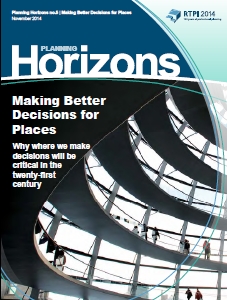Making Better Decisions for Places
In November 2014, the Royal Town Planning Institute published Making Better Decisions for Places: Why where we make decisions will be critical in the twenty-first century. This is one of five 'Planning Horizons' papers published during the RTPI's centenary year. The papers take a long term and global view of planning and the major challenges of the 21st Century.
The five Planning Horizons projects are:
- Thinking Spatially.
- Future Proofing Society.
- Promoting Healthy Cities.
- Creating Economically Successful Places.
- Making Better Decisions for Places.
Making Better Decisions for Places identifies a ‘contemporary crisis of government’ and argues that uncoordinated decision-making reduces the effectiveness of our response to major challenges. It suggests that, ‘Decision-makers at all levels need to be brought together to enable the best decisions for places, to ensure that communities are provided with the services and opportunities they need.’
The report presents examples of decisions made at inappropriate levels, and cites case studies where there are better governance arrangements, contrasting Leeds with the City of Malmö in Sweden.
It identifies four common failures:
- An inappropriate level of decision-making to deal with issues that cross administrative boundaries.
- Siloed policy and decision-making.
- Governing by borders rather than functional geographies.
- A lack of understanding of ‘subsidiarity’, and the importance of having well-resourced institutions.
The report sets out four ‘tests’ for successful devolution that might overcome these failures:
- Identifying those decisions that have a primarily national impact and those that have a primarily sub-national impact.
- Allowing policy decisions to be made according to where policies interact.
- Aligning governance arrangements with functional economic areas rather than administrative borders.
- Ensuring institutions are suitably equipped and resourced to make and implement decisions.
Cath Ranson, President of the RTPI, said, “Understanding what we want to create for local places requires a whole range of actors in the public, private and third sectors to work together – in particular communities need to be closely involved in decision-making. The challenges of making sustainable, better places won’t be resolved by one organisation alone, or indeed by one profession. Decision-makers at all levels need to be brought together to enable the best decisions for places, to ensure that communities are provided with the services and opportunities they need.”
[edit] Related articles on Designing Buildings Wiki
Featured articles and news
50th Golden anniversary ECA Edmundson apprentice award
Deadline for submissions Friday 30 May 2025.
The benefits of precast, off-site foundation systems
Top ten benefits of this notable innovation.
Encouraging individuals to take action saving water at home, work, and in their communities.
Takes a community to support mental health and wellbeing
The why of becoming a Mental Health Instructor explained.
Mental health awareness week 13-18 May
The theme is communities, they can provide a sense of belonging, safety, support in hard times, and a sense purpose.
Mental health support on the rise but workers still struggling
CIOB Understanding Mental Health in the Built Environment 2025 shows.
Design and construction material libraries
Material, sample, product or detail libraries a key component of any architectural design practice.
Construction Products Reform Green Paper and Consultation
Still time to respond as consultation closes on 21 May 2025.
Resilient façade systems for smog reduction in Shanghai
A technical approach using computer simulation and analysis of solar radiation, wind patterns, and ventilation.
Digital technology, transformation and cybersecurity
Supporting SMEs through Digitalisation in Construction.
Villa Wolf in Gubin, history and reconstruction. Book review.
Construction contract awards down one billion pounds
Decline over the past two months compared to the same period last year, follows the positive start to the year.
Editor's broadbrush view on forms of electrical heating in context.
The pace of heating change; BSRIA market intelligence
Electric Dreams, Boiler Realities.
New President of ECA announced
Ruth Devine MBE becomes the 112th President of the Electrical Contractors Association.
New CIAT Professional Standards Competency Framework
Supercedes the 2019 Professional Standards Framework from 1 May 2025.
Difficult Sites: Architecture Against the Odds
Free exhibition at the RIBA Architecture Gallery until 31 May.
PPN 021: Payment Spot Checks in Public Sub-Contracts
Published following consultation and influence from ECA.

























